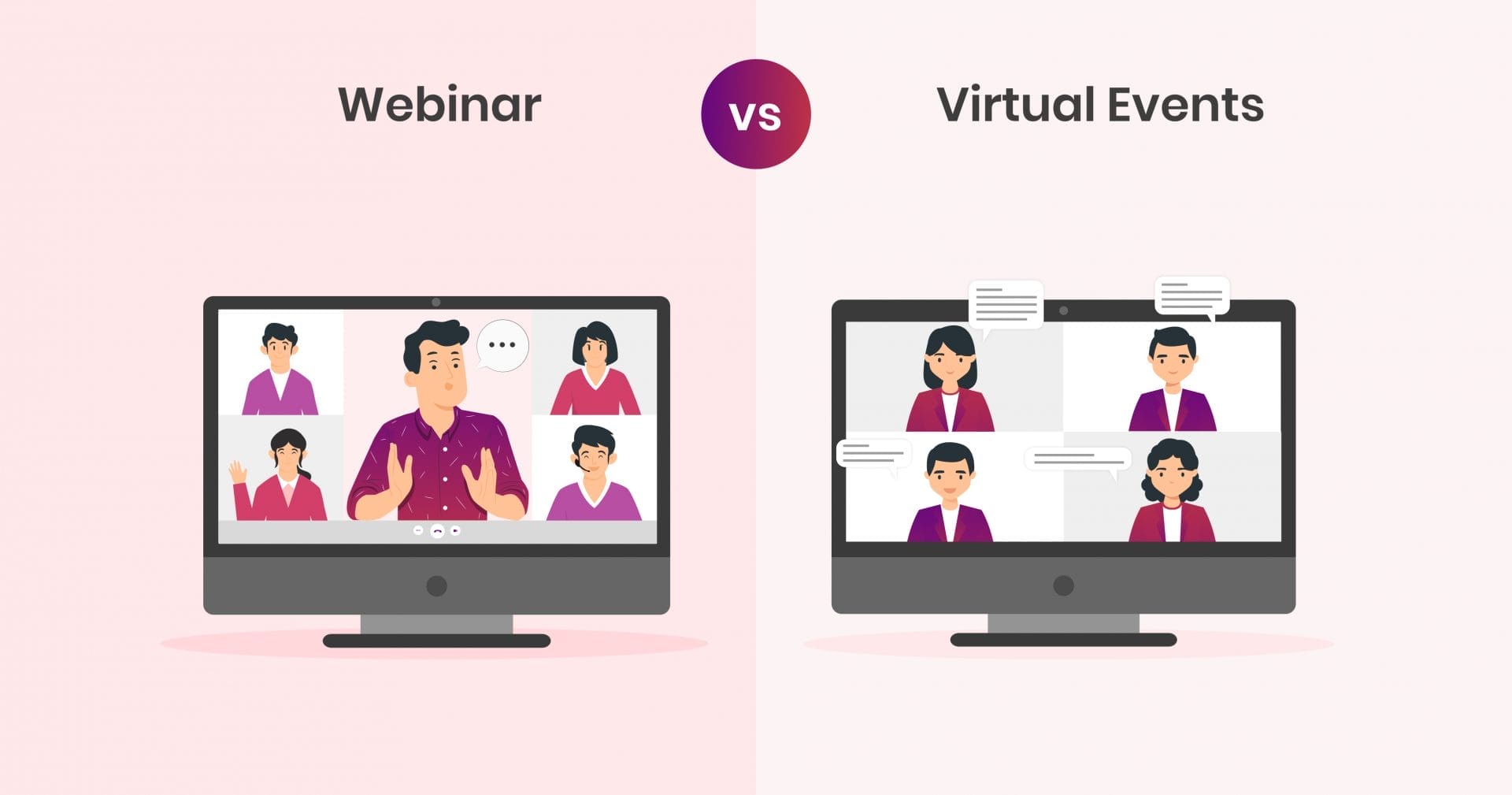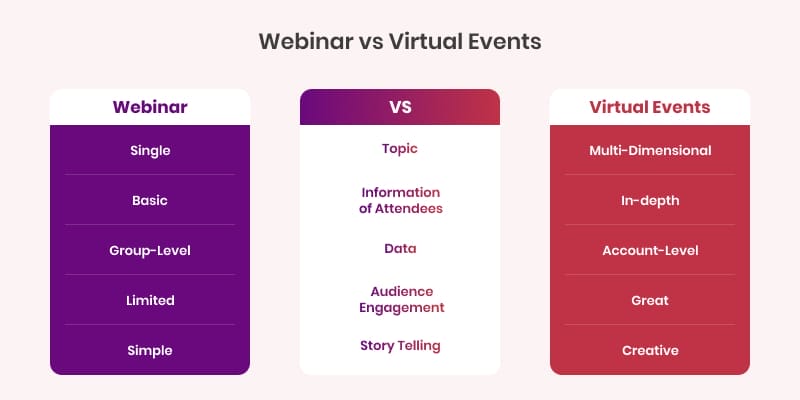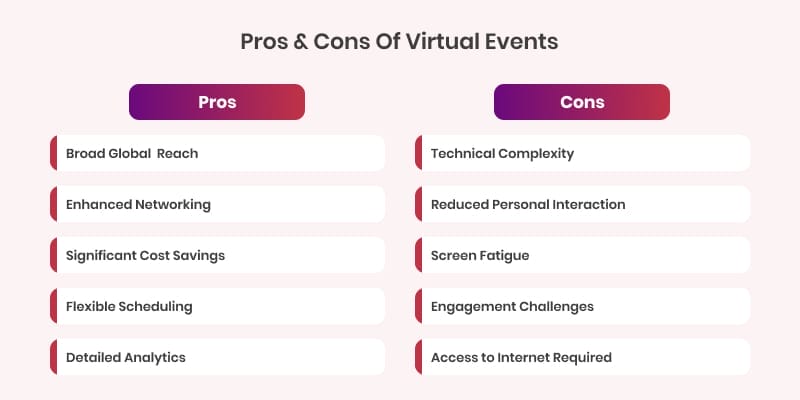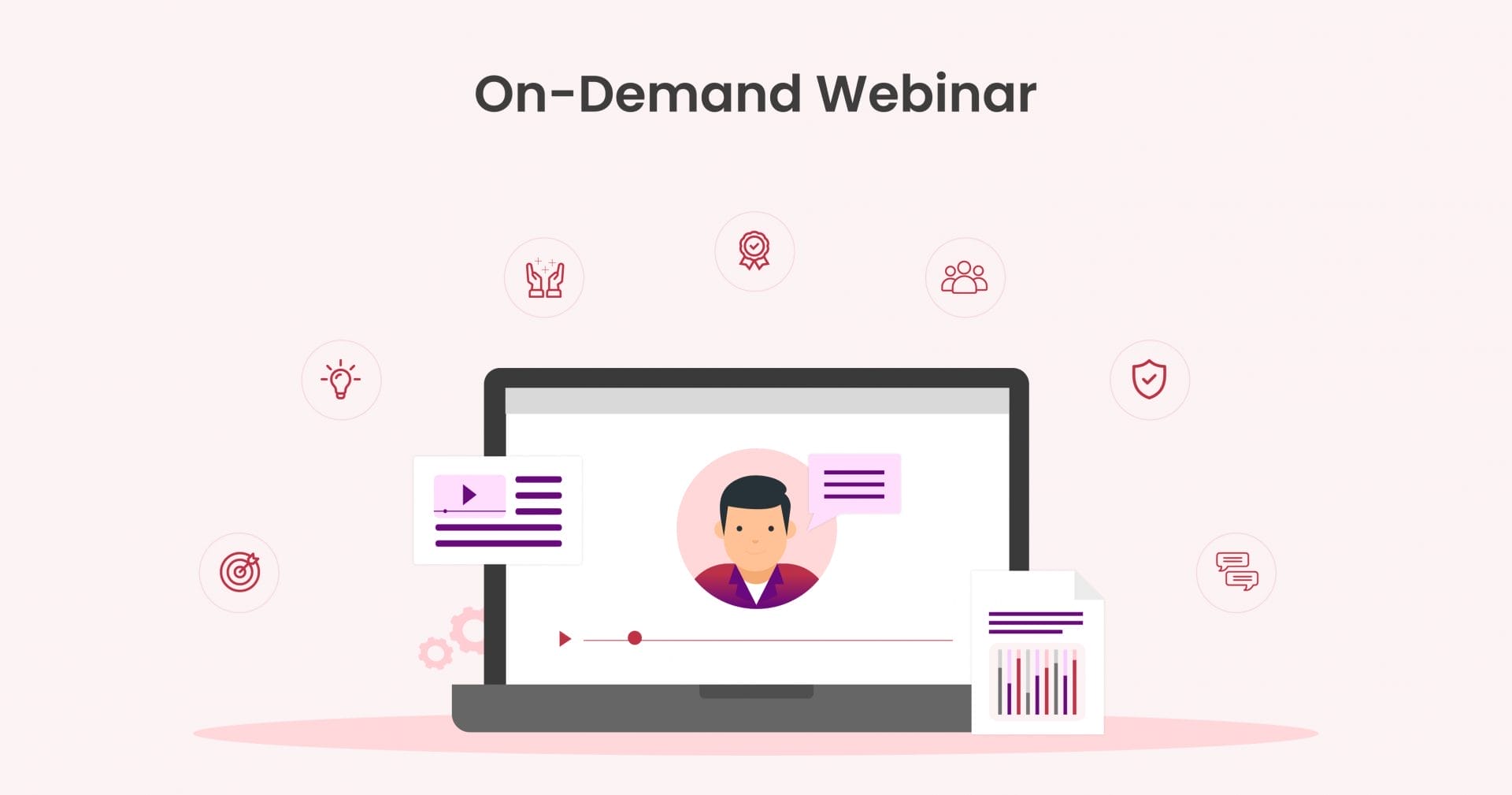The first web conference was held in 1996 to launch Microsoft’s NetMeeting. In 1999, the tech giant introduced a webinar platform named Webex. Since then, the virtual webinar market has grown significantly; especially after COVID-19, reached a new height.
Well, it was not enough.
The audience was looking for more advanced ways to engage online.
The result is the emergence of virtual events.
Many organizations are willing to organize or are already conducting multiple online events. However, they struggle to understand the right format, such as webinars and virtual events.
Are you going through the same grapple?
Through this post, I want to help you choose the right platform that meets your objectives. Together, we’ll explore every aspect related to webinars and virtual events so you can understand the differences and make the correct choice.
Let’s dive deep into
- What is a Webinar?
- What is a Virtual Event?
- Webinar vs Virtual Events
What is a Webinar? – An Overview
Definition
A webinar is an online event to educate the attendees on a specific topic.
The concept of a webinar is quite similar to the seminar.
Like a seminar, a webinar requires a group of people, a topic, a discussion, a presentation, and one or more presenters. The only difference is that seminars are conducted in person, while webinars are organized over web platforms. Thus, they are also known as virtual webinars.
In a webinar, speakers typically share knowledge or expertise through visual display and sometimes live demonstration. Also, attendees interact with the presenters by practicing in Q&A sessions or polls.
Moreover, in a webinar, you can invite 50 to 5000 people.
Usually, the time duration of a webinar is 60 minutes.
Different Types of Webinars
There are three types of webinars, which consist of
- Live Webinar
- Automated Webinar
- On-demand Webinar
Purpose
The key objective of a webinar is to educate the participants on a precise topic.
- Organizations use this digital platform to market and promote their products or services.
- Educators/professionals are harnessing the potential of webinars to teach a new skill.
Moreover, being dynamic in nature, webinars are also used for
- Introducing/explaining products or services
- Demonstrating the products
- Internal communication
Target Audience
Webinars usually target a specific audience, which involves
- Professionals of a particular industry
- Potential customers for a business
- Students seeking education on a subject
Market Growth
Webinar and Webcast Market size was valued at USD 1.15 Billion in 2022 and is projected to reach USD 4.79 Billion by 2030. – Verified Market Research
What is a Virtual Event? – An Overview
Definition
A virtual event is a broader term than a webinar. It is an online gathering that simulates the experience of a physical event.
The core aspects of the virtual events involve exhibitors, multiple sessions, networking opportunities, keynote speakers, and more.
Virtual events are the most cost-effective option if you want to hold an in-person meeting but avoid its expenses. Accessible to a larger audience, these events allow you to expand your reach with less investment. Thus, they are the best fit for your marketing strategies.
Usually, a virtual event will be conducted from 1 hour to 3 hours.
You can invite as many people as you want to a virtual event. There is no limit.
Purpose
Virtual events are more generic, multi-dimensional, and less focused than webinars. They give participants an interactive and immersive experience like a physical event. The sessions are longer and focus on less specific topics.
You can invite a large number of participants to the event. It is an effective and interactive alternative to in-person events.
You can conduct a virtual event for
- Conferences
- Trade shows
- Entertainment
- Networking
- Demonstration
- Internal communication
Target Audience
Virtual events are conducted for a broader audience that involves
- Anyone interested in a particular industry, topic, or subject
- Professionals interested in a specific topic
Market Growth
The global virtual events market size reached US$ 171.4 Billion in 2023 and is expected to reach US$ 889.0 Billion by 2032. – IMARC Group
Webinar vs Virtual Events: Difference Between Virtual Events and Webinars
If you have attended both formats once, you must be clear about how they differ.
If not, then don’t worry.
We will explore the key differentiators of these two contenders. If you struggle to decide when to consider a webinar or virtual event, you will get answers to all your questions.
1. Single vs Multi-Dimensional Topic
One key difference between virtual events and webinars is that webinars focus on one topic, while virtual events are multi-dimensional.
Let’s see how.
Webinar
Webinars are the perfect fit if your target audience is interested in gaining knowledge on a topic. In a webinar, you cannot focus on more than one topic.
Generally, speakers lead the session and share crucial information and findings with the attendees. It has a small discussion at the end, a Q&A session, where the group interacts with speakers.
Virtual Events
On the other hand, virtual events are more like in person meetings, except they are held online.
For example, if you organize a physical conference in person, the attendees can leave the room and participate in other topics, networking sessions, and chats running parallelly. Just like a physical event, virtual events allow hosts to create breakout rooms, conversations, and networking sessions within the virtual environment.
Virtual events allow attendees to customize their day and experience it like they are attending it personally. They can share knowledge and discuss different topics simultaneously.
2. Basic vs In-depth Information of Attendees
We can’t just keep doing virtual events and webinars like that. Some KPIs must be identified and implemented to judge the success of the events.
The success of any online event is measured based on the number of attendees. If you do not have the attendees’ data or have incorrect data, you cannot prove the success of your event to the top management and stakeholders.
Now, let’s understand the difference between the participants’ information provided by webinars and virtual events.
Webinar
If you have hosted a virtual webinar, you can get different data related to the attendees.
- Who attended the webinar?
- How long have they stayed with you?
- What conversations did they initiate?
- What queries did they raise? And more
Based on these insights, you can identify the engagement and interest of the target audience in your webinar, define its success, and analyze whether it helps you attain your ultimate marketing goals.
Virtual Events
In virtual events, the attendees can do more activities, which allows you to extract more data about their engagement with your event.
Participants have better content options to watch and engage with, and hosts can track this data for further improvement. Based on these insights, you can change the event format and customize the metrics to track when attendees enter each breakout room and when they leave.
3. Group-level Data vs Account-level Data
The ultimate goal for conducting virtual events or webinars is to generate revenue.
Webinars
As we have already discussed, webinars provide limited information on specific topics. It allows you to track the journey of the attendees up to a certain level where you can get insights into
- When did they join the webinar?
- How long did they stay in the event?
- How did they interact and participate in the webinar?
Virtual webinars facilitate access to basic-level data about attendees. However, the number of participants in webinars is less than in virtual events, which restricts in-depth insights.
Virtual Events
On the other hand, you can track every step attendees take within the virtual events. You can trace
- Sessions they viewed
- Questions they asked
- Every click they made
- Booth they visited
- Resources they downloaded
- Conversations they had
- Polls they answered, and more
It clearly shows that you have a lot of data to analyze and understand the participants’ behavior.
Based on these insights, you can strengthen your marketing strategy by creating a funnel of potential customers. You can interact with clients with relevant topics, products, or services that meet their requirements. Eventually, you will end up converting your attendees into clients.
4. Limited vs Great Audience Engagement
Webinars
When attendees sign up for a webinar, they are pretty clear about a topic to be discussed. They know the event is for a short time and full of information. When it comes to interactivity in webinars, there is a Q&A session. After that, there is no engagement.
Many attendees like this as they need to invest less time.
They can receive valuable information on a precise topic and return to their schedule once the webinar is over.
Virtual Events
Compared to webinars, virtual events are highly engaging.
It allows hosts to discuss different topics that interest the audience. You can run conversations on all the topics simultaneously using the breakout rooms. Live networking events, speaking sessions, and other activities occur in the breakout rooms.
As a large audience participates in a virtual event, participants can leave one room (if they lose interest in the topic) and join another room (if they feel the topic is interesting). They can move between rooms and interact with the activities happening in the respective rooms.
Attendees can take this opportunity to connect with other participants and expand their network.
5. Simple vs Creative Story Telling
Webinar
In virtual webinars, hosts have a topic in hand. You have to deliver helpful information to the attendees in a short time. Thus, you have to stick to the topic; you can not stray far away.
You can make the webinar engaging even though you follow the standard presentation style event format.
Virtual Events
The objective of virtual events is more comprehensive than just sharing information about a topic. They allow the hosts to share their brand stories or have in-depth discussions on multiple topics throughout the session.
You have the liberty to make this event significantly personalized and creative, which can interest the attendees. The way information is presented in a virtual event can be engaging for the attendees.
Webinar vs Virtual Events: Pros and Cons
Webinars: Pros & Cons
Pros of Webinars
- Focused content delivery
- Interactive Q&A and polls
- Cost-effective
- Easy to produce
- Targeted audience engagement
Cons of Webinars
- Limited networking
- Potential technical issues
- Maintaining attention
- Scheduling challenges
- Limited interaction
Virtual Events: Pros & Cons
Pros of Virtual Events
- Broad global reach
- Enhanced networking
- Significant cost savings
- Flexible scheduling
- Detailed analytics
Cons of Virtual Events
- Technical complexity
- Reduced personal interaction
- Screen fatigue
- Engagement challenges
- Access to Internet required
WebinarPress – A Robust Platform to Conduct Virtual Events & Webinar Effortlessly
WebinarPress is your go-to platform for effortlessly conducting virtual events and webinars. Designed with user-friendliness, it offers a seamless experience for hosts and participants.
Offering the advanced features, WebinarPress ensures your events are engaging and professional. Its robust integration capabilities allow you to connect with your favorite tools, making event management streamlined like never before.
Whether you’re hosting a small webinar or a large virtual conference, WebinarPress has you covered.
Ready to elevate your virtual webinar events?
Get in touch with us today to learn more about how WebinarPress can transform your webinar creation and management processes!






